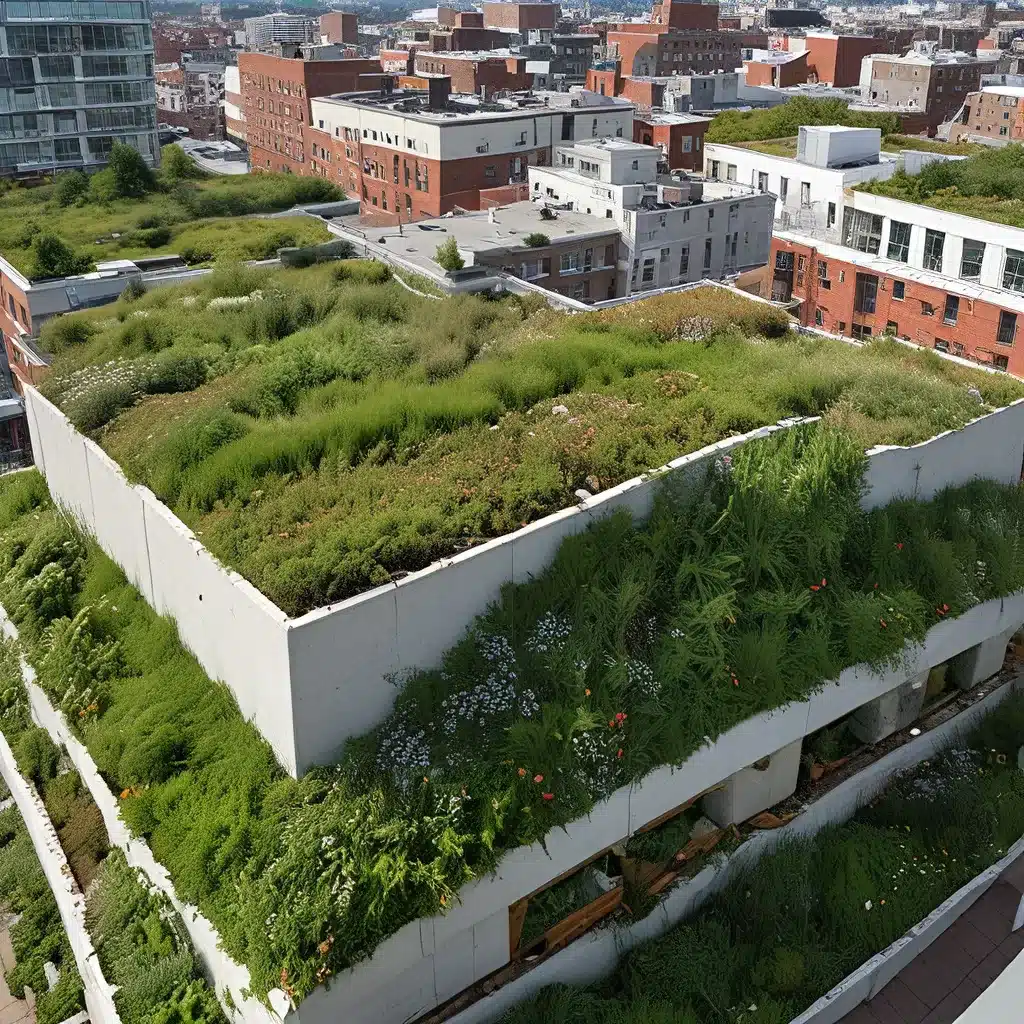
The Rise of Green Roofs: Transforming Urban Landscapes
I’ll be the first to admit, when I first heard the term “green roof,” I envisioned something straight out of a futuristic sci-fi movie – lush, verdant gardens sprawling across the tops of skyscrapers, a verdant oasis amidst a sea of concrete and steel. But as I delved deeper into this fascinating topic, I realized that green roofs are not just a visionary concept, but a practical and increasingly popular solution for making our cities more sustainable.
Retrofitting rooftops with lush vegetation, as it turns out, is a surefire way for commercial property owners to create thriving green oases that provide a host of economic, social, and environmental benefits. And as stakeholders continue to prioritize ESG (Environmental, Social, and Governance) principles, these “living roofs” offer a visually striking way to showcase a commitment to the planet and the local community.
Unveiling the Advantages of Green Roofs
But what exactly are the advantages of green roofs, and why are more and more businesses and city planners embracing this innovative approach? Let’s dive in and explore the myriad benefits that these living, breathing rooftops can offer.
Energy Efficiency and Cost Savings
One of the most tangible advantages of green roofs is their positive impact on a building’s energy efficiency. The soil, plants, and layers of material that make up a green roof act as insulation, shielding the roof from temperature swings and reducing the damaging effects of UV exposure. This, in turn, contributes to a 72% reduction in heat transfer between the interior and exterior of the building, leading to significant energy cost savings on heating and cooling.
As the commercial real estate industry continues to focus on sustainability and ESG principles, green roofs present an impactful opportunity for businesses to showcase their commitment to the environment and reduce their carbon footprint.
Urban Oasis and Biodiversity
In many urban centers, green roofs may provide the only available green space, serving as an oasis for native plants, birds, bees, and butterflies. By introducing diverse native flora, these living roofs can attract and support a thriving ecosystem, helping to restore biodiversity in the heart of the city.
Large enough green roofs can even host beehives, ensuring that local flowers are pollinated and the natural cycle is maintained. This not only benefits the environment but also provides a tangible connection to nature for building occupants and the surrounding community.
Air Quality and Stormwater Management
Green roofs also play a crucial role in improving air quality and managing stormwater runoff. Through the process of photosynthesis, the plants on a green roof absorb carbon dioxide and release oxygen, helping to purify the air and reduce the concentration of pollutants. In fact, for every 1,000 square feet of green roof space, a remarkable 40 pounds of pollutants are removed from the air annually – the equivalent of the emissions from 15 vehicles.
The soil and vegetation on a green roof also act as a natural filtration system, retaining nitrogen, phosphorus, and heavy metals and preventing them from entering local waterways and natural habitats. This helps to mitigate the impact of stormwater runoff, reducing the strain on municipal drainage systems and protecting the health of nearby aquatic ecosystems.
ESG and Sustainability
As ESG criteria continue to grow in importance within the commercial real estate industry, green roofs offer a tangible way for property owners to showcase their commitment to sustainability. Tenants and investors alike are increasingly prioritizing ESG-focused buildings, and green roofs can help set properties apart as they become more essential in the real estate landscape.
By retrofitting rooftops with lush vegetation, commercial property owners can create thriving green oases that provide economic, social, and environmental benefits. These living roofs can be a powerful tool for meeting ESG compliance and demonstrating a company’s dedication to the planet and the local community.
Overcoming Challenges: Implementing Green Roofs
Of course, the implementation of green roofs is not without its challenges. Factors such as structural integrity, maintenance, and installation costs must be carefully considered before embarking on a green roof project. But as the technology and industry expertise continue to evolve, these hurdles are becoming increasingly manageable.
If you’re a commercial property owner interested in exploring the benefits of a green roof, it’s worth consulting with a reputable roofing services provider to assess the feasibility and potential for your building. With the right planning and execution, green roofs can unlock a world of sustainable possibilities and transform urban landscapes into vibrant, eco-friendly hubs.
Embracing the Future: Green Roofs and the Sustainable City
As we look to the future, it’s clear that green roofs will play an increasingly important role in the evolution of our cities. By integrating these living, breathing rooftops into our urban infrastructure, we can not only enhance the aesthetic appeal of our built environment but also tackle pressing challenges like climate change, biodiversity loss, and resource scarcity.
While the journey towards a more sustainable future may have its fair share of obstacles, the promise of green roofs is undeniable. As stakeholders continue to prioritize ESG principles and the demand for eco-friendly solutions grows, these verdant oases on our rooftops will likely become a hallmark of the modern, climate-resilient city.
So, the next time you gaze up at the rooftops of your city, I encourage you to imagine the possibilities – a world where nature and the built environment coexist in harmony, where the greenery of the rooftop is just as essential as the bricks and mortar beneath it. It’s a vision that’s not just a dream, but a tangible reality that we can strive to achieve, one green roof at a time.